|
|
|
|||
|
|
||||
|
|
||||
| The Smoky Addiction | ||||
|
|
HOME | SITE MAP | FORUM | CONTACT |
|
||
|
ABOUT | MOTORS | MODELS | ARCHIVE | HISTORY | STORE | FAQ | LINKS
|
|
|
|
|
|
|||||||||||||||||||||||||||||||||||||||||||||||||||||||||
|
The Smoky Addiction 10
(October 2005)
by Roger Simmonds Reprinted from SAM 35 Speaks, October 2005 When I was a very young lad, practically the only flying models I could afford, or with which I had any success, were the small chuck gliders stocked by the Local General Store. These models really did fly and were attractively made of printed balsa, though the fin was, I remember, thin card. They were sold in paper bags and cost nine old pence: a considerable investment in those days, representing as it did a whole week’s pocket money. I well remember the frustration occasioned by their damage (repairs with Seccotine took several millennia to set) and the trauma of their total loss due to confiscation by irate allotment holders, landing in inaccessible gardens, or being eaten by (rarely) unclimbable trees. Counselling was of course unavailable in those unenlightened early post-war days, and indulgent uncles able and willing to cough up (they invariably smoked Woodbines) the 9d to buy another model were very thin on the ground? “What happened to the first one?” they would gasp. But oh, the happy days that were spent with these rudimentary models! What a pity halcyon days are apparent only in retrospect. |
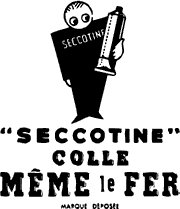
- L’Illustration, 1922
|
|||||||||||||||||||||||||||||||||||||||||||||||||||||||||
|
I never did progress to the more sophisticated ‘chuckies’ sold by proper model shops – they were beyond my purse – and I never did buy a Keil Kraft Spook. By the time I could afford one, and was trusted to cycle to the Model Shop alone, I considered it beneath me. This was a pity, as I would have had more success with one of these than with many of those wretched ‘Junior Scale’ models or any of my own designs. Oh, the wilfulness and purblindness of youth! – attributes I have, unfortunately, nurtured and retained into disreputable second childhood. |

- Mike Brannan
|
|||||||||||||||||||||||||||||||||||||||||||||||||||||||||
|
|
|
|||
A lovely story: but what has this got to do with Jetex, you ask? Well, though the Spook was originally designed for hand or catapult (‘mini bungee’) launch it is a dead ringer for rocket (Rapier) power. Fortunately we have some historical justification for doing this. John Park, who wrote the evocative ‘Jetex Days’ for the Aeromodeller back in 1990, remembers: “The Spook was one of the best-flying Jetex models I had as a young boy in the mid-fifties, surpassed only by Bill Dean’s Vulture. My flights with this model – a standard kit, still freely available in 1956 – were made with an original ribbed case Jetex 50 mounted on top of the wing, right above the CG so that it glided the same whether loaded or unloaded. As a glider, it was trimmed for a wide left turn, and this was unaltered when it was converted to Jetex. On its first powered flight it climbed away in wide left-hand circles and reached a very respectable height in the fifteen seconds of motor run. The afternoon was calm and it settled into a fast but shallow glide in the same direction. I can only guess at the duration – maybe fifty seconds – and it took me and my buddy a good half hour to find the model in the bracken, but this simply added to my pleasure”. |
|
 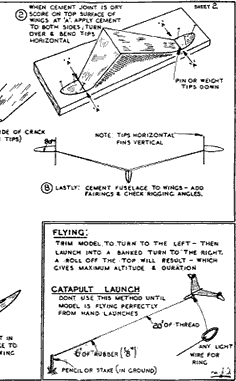
- Keil Kraft, 1947
|
|
|
|
|||
|
The Spook, at 12.5" span, may look awfully small for a Jetex 50, but John (P) comments that, for all that power, it didn’t actually climb as fast as his beloved Vulture. This may be a consequence of the considerable weight of the motor and its position, on top of the wing and angled slightly downwards, controlling any looping tendency. John now believes, with the benefit of hindsight, that an Atom 35 would have been a better choice of propulsion. Steve Bage agrees, and built his Spook for Rapier L1 [right]. Steve’s model weighed about 5 g undoped (as was the original) and without the pylon-mounted motor. He couldn’t resist a few exploratory glide tests before ‘lighting the candle’: “It goes very well from a chuck, no nose or tail weight was required and a dead straight glide. I tried a catapult launch, but it performed a big loop, doing its best to hit me in the back of the head. I guess for catapult launches it needs to be trimmed to roll off the top, but for Rapier power I’ll leave it as it was as any trimmed in turn will tighten up with a rocket pushing it along. I’m estimating that even with a low power L1 onboard it will have a thrust-to-weight ratio of 0.6-0.8 (depending on rating) which should be enough for a stellar performance”. Steve’s estimate of a ‘stellar’ performance’ proved correct: “The addition of the motor made the glide much faster and a little bit steeper […] I lit the fuse and tossed the little model skywards […] much to my surprise it climbed nearly vertically and kept on until the motor quit, at which point I could barely see it. Though I was desperately hoping for a glide like a brick unfortunately [!] it flew quite well […] out of the field behind the trees and into an area of high grass and bushes. I made a token search but it was hopeless. I’m not sure if I should be happy it flew so well or miserable because I’ll have to build a new one!” The Rapier L1 is obviously a good match, but some sort of light and reliable D/T is obviously called for! The plan, available on the Jetex.org website, seems to indicate that the wing is Howard Metcalfe has again been challenging my deep-seated prejudice against profile and all-sheet models. His Harrier and Starfighter went very well at Middle Wallop at the end of August, whilst I remained earthbound, not wishing to risk my more delicate creations on the windy Sunday. Howard’s very light L1 powered Hawks, which have a high power-to-weight ratio, were even more impressive. I am very tempted by Howard’s Hawk, as; (a) I really need a model that can cope with these very ‘active’ and windy days; (b) Howard has a lovely plan available; (c) modelling with ‘Depron’ (which I haven’t attempted before) may be more acceptable in rented accommodation. |
  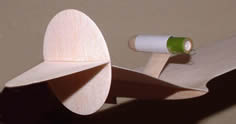
- all photos by Steve Bage
|
|||
|
Also wanting also something to emulate the ballistic performance of Howard’s Starfighter, I looked again at the Jetex Viper. There was no plan as such for this prefabricated Sebel kit, and the plan-view I have (right) is barely adequate to make more than a simulacrum of the real thing. I do, however, have a ‘cutter layout sketch’ (not suitable for publication here) to build from. On the evidence of Steve’s Spook, Mike Stuart’s Space-Jet and John Digby’s Fizzel Fazzel (of which more anon), these simple (but sophisticated) all-sheet models go better with Rapiers than they did with the original Jetex motors, so exchanging the steel-bodied 50C (which weighed about 15 g loaded) for a Rapier L2 (weighing less than half this) will reduce the Viper’s wing loading, ensuring an even better climb to the upper reaches of the troposphere. I don’t think there is much likelihood of losing it in a thermal, but you never know, given some of the days we have been having of late. Could Rapier exhaust be contributing to Global Warming? |
 Jetex (Sebel) all-sheet Viper Missile for 50C (not 50R) |
|||
Another all-sheet model ripe for a Rapier makeover is Bill Dean’s Jetex Canard (see André Bird’s example right). This unusual design (published in Model Aircraft, Jan. 1951) has appeared at least once before in SAM Speaks (Oct. 1989). Unfortunately, my best copy of the plan, reproduced below, is scarcely good enough to build from.
- Model Aircraft, Jan. 1951
|
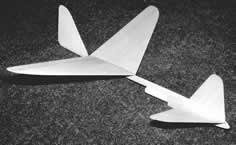 André Bird’s recreation of Bill Dean’s Canard (1951). Note tube for Rapier L2 in front of the CG
- André Bird
|
|||
|
Rocket-powered canards actually have a long history (see March’s Smoky Addiction), and, contrary to what I and most people have believed, the first manned rocket plane was not the legendary Opel-Hatry Rak-1, but a converted glider of canard configuration. The story appears in David Foster’s recent book Challenging the Sound Barrier, according to which: “The first flight with solid-fuel rocket motors took place on 11 June 1928 at Wasserkupe, when Fritz Stamer flew an RRG Ente (duck – canard in French!) powered by two 44 lb. thrust Sander motors installed in the back of the short fuselage for 35 seconds [right]. A second test flight with two 55 lb. rocket motors lasted 70 seconds and covered 4,000 ft. including a 180 degree turn. A rocket motor exploded on the third flight.” This excellent and informative book (available from Midlands County) also has what must be a very rare photo of the Rak-1 (Rakete or Rocket 1) in flight [right]. As has been widely recorded, this machine, powered by no less than 16 motors giving a total thrust of 900 pounds, made at least one successful flight in September 1929 with the daring Fritz von Opel at the controls. It crashed when propelled by more powerful motors: a result all to familiar to us rocketeers. The Rak-1 has featured in SAM Speaks a number of times, probably because it is one of the few rocket ships that can be authentically modelled in miniature. But, as Chris Strachan has remarked, the 1959 Model Aircraft design for Jetex 50 is in fact not that accurate, and its aspect ratio of 5.3 should be closer to 7. Walter A Musciano’s earlier design on the right (Air Trails, 1951, reprinted in the 1951 AM Annual) is rather more accurate. With a span of just over 22" and very light build (note the holes in the wing ribs), it must have been quite overpowered by a Jetex 100, and is probably more suited to a Rapier L2. |
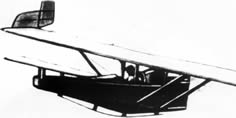 RRG Ente (1928) – two successful rocket flights are claimed
- Challenging the Sound Barrier, D Foster
(HPM, 2004) 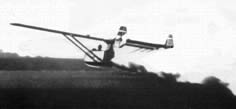
- ibid
 Walter A Musciano’s Rak-1
- Air Trails, 1951
|
|||
|
Anthony Druce slightly reduced the 1959 MA design for Rapier L2, and this was performing splendidly at the SAM Gala at Old Warden this year (see photo right). Note Fritz in the driving seat. It is something of an irony that Mike Stuart’s Mystère IV with inauthentic stringers flies around in a stately fashion, whilst Anthony’s Rak-1 with an ‘authentic’ structure climbs wonderfully but unrealistically in a steep spiral that would have required poor old Fritz to wear a g-suit. Oh well, it just goes to show one can’t have everything! A couple of extra bays in the wings will add accuracy and may slow it down a bit. |
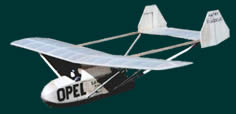 Anthony Druce’s Rak-1
- Roger Simmonds
|
|||
|
Returning to rocket-powered canards, Bob Pickernell has finished his Vickers V.559 [right]. It weighs a creditable 25 g, but Bob is not altogether pleased with the result, commenting that it is ‘under-engineered in the wrong places to save weight’. OK, one can see that a few more stringers would not have gone amiss, but it is still a unique and good looking model. Bob reports that the longitudinal stability and glide performance are OK but its lateral stability is marginal under power, something of a surprise given the performance of his all-sheet prototype and the ‘lobster claw’ arrangement of the foreplanes. Fortunately Bob is not too dispirited, and is contemplating a Mk 2. Canards in general and canard jets in particular are something of a rara avis on the flying field. In an attempt to redress this imbalance I sent Steve Bage my preliminary study for an L2 powered Nord Griffon II. Steve liked the ‘plan’, and it generated some correspondence as to where the CG (and in consequence the motor) should be. To try to answer this important question I turned to an article published in the 1953 Aeromodeller Annual, ‘The design and development of Delta Models’ by John Fozard [right]. As has been said before, 1953 was a great year for Jetex, and, as if one erudite article wasn’t enough, this AM Annual also included Bert Judge’s authoritative review, ‘The latest developments in Jetex’, which is still required reading for all Jetex enthusiasts. ‘The design and development of Delta Models’, full as it is of equations and minuscule and complicated diagrams, and whose prose appears to have been edited by R H Warring, is, alas, as heavy going as Bert’s is a pleasure to read. Still, Mr Fozard’s essay is worth persevering with: his aim was after all to stimulate new designs, and his discussions are still relevant. For example, he asks, “What is the point of the canard delta?”. You will remember I too have had my doubts about deltas with tails. According to Fozard, the addition of a “leading tailplane” gives greater damping in pitch compared with a similar tailless delta, and it is a much more powerful trimming device than the normal trailing edge flaps of the plain delta (see drawing right; note the incidence of the foreplane). He continues: “The great difficulty with this type has always been to obtain a reliable estimate of the neutral point. The solution has usually been to place the c.g. by sheer guess well forward and subsequently find out by flight test how far back it can be allowed to move before the loss of longitudinal stability is encountered. This process has inevitably led to much balsa being broken, and generally caused canard models to be regarded with somewhat jaundiced eyes. By the use of delta planforms, however, the correct positioning of the c.g. is greatly facilitated”. He then comments that the wing and foreplane should be “of the same geometric planform”, and refers us to his diagrams. As far as I can gather from these – which to tell the truth is not very much – the CG needs to come a little forward of the position required on a “true delta”. Fozard, an experimental modeller as well as a fine aerodynamicist, included details of a Jetex powered canard delta (right) to prove his theories. He writes, “The model was stable in flight, with no tendency towards spiral instability, a very common failing of model deltas … unfortunately, the weight of over 7 oz proved overmuch for an augmented Jetmaster”. A Scorpion would have been better; the Jetmaster powered Swift, it will be remembered, weighed about 4˝ oz. A sketch of his ambitious and impressive model appears below. Impressionable lad that I was, I made a half-size model for RTP; even at 2 oz, and powered by a PAA Loader, it refused to leave the ground. Perhaps the CG was in the wrong place. 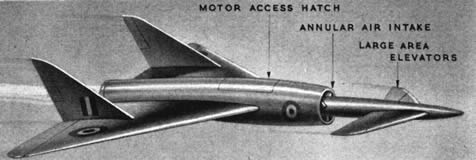
- Aeromodeller Annual, 1953 (p. 114)
|
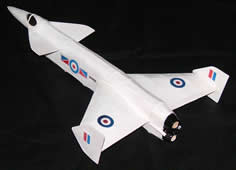 Bob Pickernell’s unique V.559 for Rapier L2. Note the dihedralled foreplanes and nicely detailed Spectre rockets
- Bob Pickernell
 J W Fozard with his Free Flight Canard Delta “at a late stage of construction”
- Aeromodeller Annual, 1953 (p. 114)
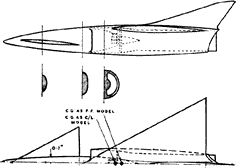  Fozard’s Jetmaster Canard (1953) Span: 19"; length: 26"; wing area: 125 sq. in.; weight: ‘over 7 oz.’
- Aieromodeller Annual, 1953 (p. 116)
|
|||
|
Having had a good time at the SAM meeting at Middle Wallop the week before (losing or damaging only a few models), I didn’t go to this year’s ‘Flying Aces’ at Peterborough, where, unusually for this early autumn event, conditions were similar; that is, quite rough: hot and sunny, but with a 10-12 mph wind and turbulence over the trees at the edge of the field. The main problem was the wind direction, and any model airborne for much more than a minute strayed out over the lake. The boating fraternity was thus kept happily employed throughout the day retrieving soggy models. Nevertheless, there was plenty of Rapier reaction action, from, amongst others, Mike Stuart, Steve Bage, John Digby, Pete Smart and Richard Crossley. Inevitably, the rate of attrition was high. Steve Bage rekitted his Fizzle Quick, which he says was quite overpowered by an L2, and then misappropriated, and misplaced, his son’s Spook OOS on its third powered flight. John Digby’s Fizzel Fazzel, completed only the night before the event, similarly disappeared, but on its first trimming flight. Even more distressingly, John also lost his lovely if wayward Horten XIII Delta [right], failing to find it despite a long and exhausting safari. Mike Stuart, who broke a wing on his lightly loaded Mystère IV twice in the Scale Event, had better luck with his new L2LT powered Space-Jet in Duration. He reports: “A second flight was timed at 115 seconds OOS behind the trees. I spotted it out on the lake where it was recovered by a kind couple in a pedalo. This model was not doped, so it took a while to dry out. Despite some wavy tail surfaces it still managed a 46 second final flight later in the day.” |
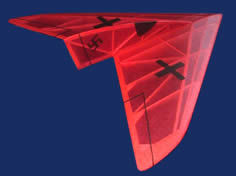 John Digby’s Horten XIIIb
- John Digby
|
|||
|
Pete Smart bravely demonstrated his multi-engined electric Gigant, but his Rapier scale fleet didn’t relish the blustery conditions, and the more heavily loaded scale models coped better. Steve flew his MiG 21 to good effect after correcting a sun-induced wing warp, and both he and Mike put in some fine, if unpredictable, flights with their Thunderchiefs, using Rapier L2s of various ratings – the higher the better it would appear in the turbulence. Mike says, however, that Steve’s P.1121 [right] – now trimmed out with a thrust vane in the trough – was the star of the show. Having seen the video, I can only agree. At the end of the day there were still a good few models out there in the undergrowth … or at the bottom of the lake, but despite the carnage a good time was had by all, even if many went home with fewer models and more scratches and bruises than they would have liked. Steve’s Fizzle Quick and John Digby’s Fizzel Fazzel [right] (a 1959 Bob Walters design for Jetex 50C) illustrate one of this month’s themes, i.e. the performance of classic all-sheet Jetex duration models when reincarnated as lighter models for Rapiers. John downloaded the “I put this together after reading what Mike S and Steve B were making [the Space-Jet and Spook respectively] and I thought it might be fun to enter the Peterborough event. I was struck by the simplicity (read ‘quick to build’) of this design. As drawn it is more suited to a Rapier L2, so I scaled it down to 12.8" span to suit some 60 mN L1s. The wing is light 3/32" balsa, whilst the fin and tailplane are 1/32". The fuselage is a sandwich of 1/8" balsa and 1/8" sq spruce. I had some reservations about the bottom-mounted motor and problems associated with launching, but in reality it was very easy to launch by holding the nose in front of the motor”. John lengthened the fuselage in front of the wing to reduce the need for nose weight, and his model weighed only 7 g, nicely decorated (undoped, as seems to be the custom with these sorts of models, but with a single coat of sanding sealer). The Fizzel Fazzel had an impressive thrust-to-weight ratio even with 60 mN L1s: I’m not altogether surprised it flew away at the first opportunity. The fun (if that’s the right word) to be had with these models is most encouraging. Who will be the first to try the famous Vulture with a Rapier? But please fit a D/T. |
 Steve Bage’s P.1121
- Steve Bage
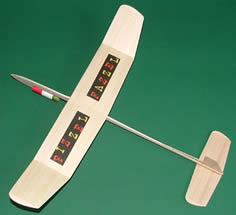 John Digby’s Fizzel Fazzel
- John Digby
|
|||
|
|
||||
|
|
|
|||
|
|
|
|
|
|
|
|
Acknowledgements - Article: Roger Simmonds - Illustrations: Roger Simmonds, Steve Bage, André Bird, John Digby, Mike Stuart |
|
|
|
|
ABOUT | MOTORS | MODELS | ARCHIVE | HISTORY | STORE | FAQ | LINKS |
|
|
Terms of Use
|
Queries? Corrections? Additions?
Please
contact us.
|
|